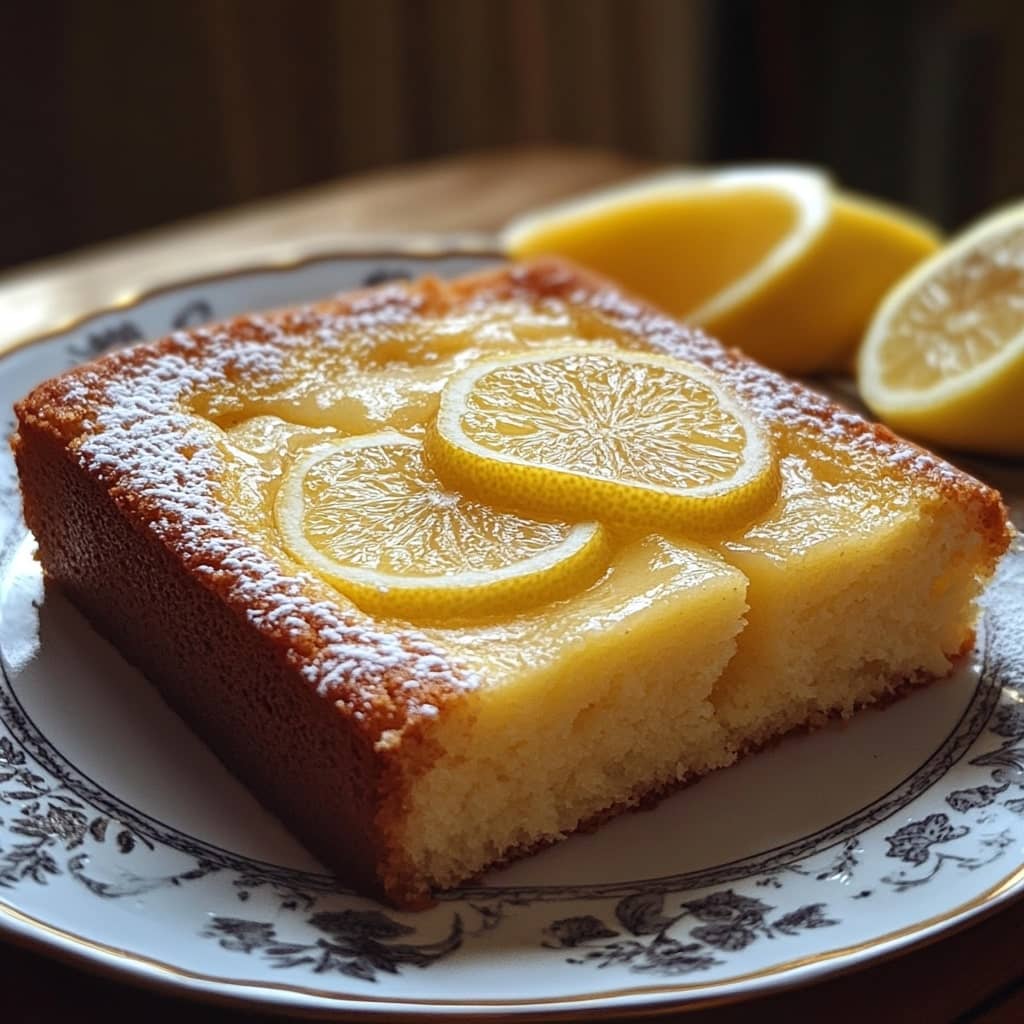Lemon Yogurt Anything Cake: A Bright, Versatile Classic for Every Occasion
Lemon Yogurt Anything Cake is a moist, tender, and incredibly adaptable cake that shines with the fresh zing of lemon and the subtle creaminess of yogurt. This delightful dessert has earned its name because it can be “anything” you want it to be—served plain with tea, topped with fruit and whipped cream for brunch, layered with frosting for celebrations, or even used as a base for trifles and parfaits. Its lightly tangy profile makes it a refreshing alternative to heavy, butter-laden cakes, and its forgiving texture welcomes add-ins like berries, nuts, or chocolate chips without compromising its fluffy crumb. Loved by bakers of all skill levels, it’s a foolproof go-to recipe that tastes like sunshine and comfort in every bite.
The History of Lemon Yogurt Cake
The roots of yogurt cake trace back to Europe, particularly France, where “Gâteau au Yaourt” is one of the first recipes many children learn to bake. It’s traditionally made with simple ingredients measured in yogurt pots, promoting an easy, no-fuss method perfect for home kitchens. The addition of lemon has long been a natural pairing, as citrus enhances yogurt’s natural tanginess and balances the sweetness of the cake. Over time, the lemon yogurt cake evolved into a popular variation worldwide, cherished for its light texture, simple preparation, and adaptable nature. The “anything” moniker emerged in modern culinary circles to reflect its flexibility—it can be made in loaf pans, round pans, bundt molds, or muffin tins; dressed up or down; flavored or plain. Whether baked for birthdays, brunches, or just because, this cake has earned its status as a timeless favorite.
Ingredients Breakdown
The base ingredients of a Lemon Yogurt Anything Cake are pantry staples, making it an easy go-to for spontaneous baking. You’ll need all-purpose flour for structure, baking powder for lift, and a pinch of salt to enhance flavor. Sugar provides sweetness and helps with browning, while plain or Greek yogurt adds moisture, a soft crumb, and a slight tang that keeps the cake from being overly rich. Lemon zest and juice offer brightness and a citrusy aroma that defines the cake’s flavor. Eggs bind the ingredients and contribute to the rise, and a neutral oil—like vegetable or canola oil—adds richness and tenderness without overpowering the lemon. Vanilla extract is often added for depth, and optional ingredients like berries, poppy seeds, or nuts can be folded in for variety. The result is a batter that comes together quickly and bakes into a tender, golden cake perfect for any occasion.
Step-by-Step Recipe
- Preheat Oven and Prepare Pan: Set your oven to 350°F (175°C). Grease a 9-inch round pan, loaf pan, or line with parchment paper.
- Mix Dry Ingredients: In a medium bowl, whisk together 1½ cups flour, 2 teaspoons baking powder, and ½ teaspoon salt. Set aside.
- Combine Wet Ingredients: In a large mixing bowl, whisk together 1 cup plain yogurt, ¾ cup sugar, ½ cup oil, 3 eggs, 1 teaspoon vanilla extract, the zest of 1 lemon, and 2 tablespoons of fresh lemon juice until smooth.
- Combine Wet and Dry: Gradually add the dry ingredients to the wet mixture, stirring gently with a spatula or whisk until just combined. Do not overmix—this ensures the cake stays light and fluffy.
- Optional Add-ins: If using add-ins like blueberries, raspberries, or chocolate chips, gently fold them in now. Toss them in a bit of flour first to prevent sinking.
- Bake: Pour the batter into the prepared pan and smooth the top. Bake for 35–45 minutes, depending on pan size, or until a toothpick inserted into the center comes out clean and the top is golden brown.
- Cool: Let the cake cool in the pan for 10 minutes, then transfer to a wire rack to cool completely.
- Serve: Serve plain, dusted with powdered sugar, topped with glaze, or accompanied by fresh fruit and whipped cream.
Tips for the Perfect Lemon Yogurt Anything Cake
Use fresh lemon juice and zest for the best flavor—bottled juice won’t deliver the same brightness. Full-fat yogurt gives the richest texture, but low-fat versions work as well. Room temperature eggs and yogurt help the batter mix more evenly and rise properly. Don’t overmix the batter once the dry ingredients are added; mix just until combined to avoid a dense texture. For added flair, top the cake with a simple lemon glaze made from powdered sugar and lemon juice. A light brushing of syrup while the cake is warm enhances moisture and flavor. Always test doneness with a toothpick, and allow the cake to cool completely before slicing for clean, even cuts. If using a loaf pan, line it with parchment for easy removal.
Variations and Customizations
This cake is called “anything” for good reason—it’s endlessly adaptable. Replace lemon with orange, lime, or grapefruit zest and juice for a citrus variation. Fold in a handful of fresh or frozen berries, chopped nuts, shredded coconut, or poppy seeds for added flavor and texture. Swap the vanilla extract with almond, lavender, or rose water for unique aromatic twists. Make it dairy-free by using coconut yogurt or a plant-based yogurt alternative. Bake it in muffin tins for individual servings, or layer it with whipped cream and jam for a rustic dessert. Add a simple glaze or drizzle with melted white chocolate to dress it up. For a fall version, skip the lemon and mix in cinnamon, nutmeg, and chopped apples or pears. The cake also pairs beautifully with mascarpone cream, yogurt frosting, or a dollop of crème fraîche.
Health Considerations and Nutritional Value
Lemon Yogurt Anything Cake offers a more balanced nutritional profile than many traditional cakes. Yogurt adds protein, calcium, and beneficial probiotics that support gut health. Using oil instead of butter reduces saturated fat and gives a more tender crumb. The cake is lower in sugar than frosted cakes and can be made even lighter by reducing the sugar or using natural alternatives like honey or maple syrup. Whole wheat flour or almond flour can be used in part for added fiber and nutrients. For a lower-calorie version, use nonfat yogurt and skip the glaze or toppings. The cake is also naturally lower in cholesterol compared to butter-based recipes. With simple swaps, it can be made dairy-free, gluten-free, or egg-free to suit dietary needs. It’s a dessert that satisfies without excess and can be tailored to fit a wide range of health goals.
FAQ
Can I use flavored yogurt? Yes, but keep in mind it will affect the sweetness and flavor of the cake. Plain yogurt is best for controlling flavor.
How should I store the cake? Store at room temperature in an airtight container for up to 3 days or refrigerate for longer freshness.
Can I freeze this cake? Absolutely. Wrap slices or the whole cake tightly in plastic wrap and freeze for up to 2 months. Thaw at room temperature.
Why is my cake dense? Overmixing the batter or using cold ingredients can lead to a denser texture. Mix gently and use room temperature ingredients.
Can I make it vegan? Yes, substitute eggs with flax eggs or applesauce, and use plant-based yogurt and milk.
Can I make cupcakes with this batter? Definitely—just reduce the baking time to 18–22 minutes and use cupcake liners.

lemon yogurt anything cake
Ingredients
- ½ cup 120 ml vegetable oil or any neutral-flavored oil
- 1 cup 200 g granulated sugar, plus 1 tablespoon (15 g) for coating the berries
- Zest and juice of 2 large lemons or 3 small to medium lemons
- 3 large eggs
- ½ teaspoon vanilla extract optional; can be omitted
- 1 cup 225 g plain yogurt — whole milk, low-fat, or Greek-style all work
- 2 teaspoons baking powder
- ½ teaspoon kosher salt
- 1½ cups plus 1 tablespoon 205 g all-purpose flour
- 1½ cups 250 g blueberries, fresh or frozen (see Note below)
- Powdered sugar for dusting optional
Instructions
- Preheat the oven to 350°F (175°C) and lightly grease a standard loaf pan with nonstick spray. For easy removal, you can also line the pan with a parchment paper sling.
- In a large mixing bowl, combine the oil and 1 cup of granulated sugar. Finely zest all the lemons you’re using directly into the bowl and whisk the mixture together. Add the eggs, vanilla (if using), and yogurt, whisking until smooth and well blended.
- Sprinkle the baking powder and salt evenly over the surface of the mixture, then whisk thoroughly to ensure everything is evenly distributed. Add the flour and blueberries, stirring gently just until combined—avoid overmixing.
- Pour the batter into the prepared loaf pan and bake for 60 to 75 minutes, or until a toothpick inserted into the center comes out clean.
- While the cake is baking, juice the zested lemons to yield about ⅓ cup of juice. Place the juice in a small saucepan with the remaining 1 tablespoon of sugar and heat over medium, stirring until the sugar is fully dissolved.
- As soon as the cake comes out of the oven, brush the warm lemon syrup over the top. If the syrup isn’t soaking in easily, use a skewer to poke small holes across the surface of the cake to help it absorb.
- Allow the cake to cool completely in the pan. Once fully cooled, run a knife around the edges to loosen it and carefully transfer it to a serving plate. Dust with powdered sugar if desired and slice into 1-inch pieces to serve.
- Make ahead: The cake keeps well at room temperature for up to 3 days, or in the refrigerator for up to 1 week. It also freezes beautifully—wrap it tightly in plastic wrap, and let it defrost at room temperature a few hours before serving.

